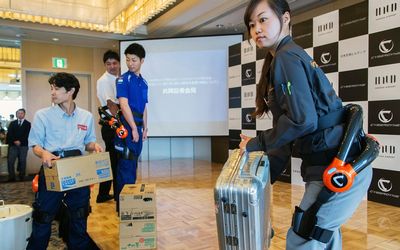IT TAKES the engineer about two minutes to adjust the exoskeleton. It is worn like a rucksack, with large straps around the chest to hold it tight. The rest is made up of two disks located on the hips, at the body’s rotation axis, and thin rods join cushions on the front part of the thighs.
The device weighs a little over 6kg, distributed between the shoulders and thighs.
A 30kg crate needs to be lifted. The first attempt, without the exoskeleton, results in immediate tension in the lower back muscles and the crate hardly moves.
On the second try, the engineer activates the exoskeleton. The crate can now be lifted five, six, seven times in a row without effort. The movement is almost abrupt, but is still controllable.
The assist suit AWN-03 is the first commercially available product from Japanese company ActiveLink, a Panasonic subsidiary. ActiveLink was among the brands that participated recently in Tokyo’s International Robot Exhibition, the world’s largest robotics show.
In the exhibition’s "social" and "service" areas, where there were humanoid prototypes designed to intervene in natural disasters, all eyes were on the exoskeletons.
Their development and implementation in Japan comes within a particular context. A low birthrate and a strict immigration policy mean that the country’s population is ageing fast.
From 127-million people in 2014, the number of inhabitants is expected to drop to less than 100-million by 2050.
Among the primary collateral effects are a significant workforce reduction and growing demand for elderly care, consequences that call for new measures.
Prime Minister Shinzo Abe and his government intend for innovation to boost the performance of the working-age population. Intensive automation is one of the crucial measures, especially in the services sector and for small-and medium-sized businesses. Larger groups in the car-making and electronics industries are already highly robotised.
...
THE government’s New Robot Strategy report, published early last year, calls for turning Japan into a vast "robot hub" by focusing on the conjunction of the Internet of Things and a daily robot presence.
According to the Mitsubishi Research Institute, service-oriented robotics in Japan will grow from a $500m industry in 2014 to a multibillion-dollar one by 2035.
Exoskeletons in Japan find their utility at the junction of three challenges: healthcare, physical assistance, and maintaining the country’s level of production despite a shrinking workforce.
ActiveLink’s website features images of a man whose hair has started to turn gray lifting up a small container without effort, and photos of a young woman easily transporting what seems to be a heavy parcel.
Yasunori Nishi, an engineer at Fukunishi, the company that sells ActiveLink products, says the exoskeleton detects the user’s movements and assists, thanks to a lithium-ion-battery-powered electric engine. It costs about $10,000.
The Japanese are not the only ones working on exoskeletons.
In Europe and in the US, a number of projects will soon be unveiled in the sectors of defence, industry, and rehabilitation.
Robo-Mate, an exoskeleton with passive arm modules, has received support from the European Union and is said to have attracted interest from Fiat. The US company Lockheed Martin has developed Fortis, a nonmotorised exoskeleton that transfers loads endured by the hands on to the hips and feet.
Swiss startup Noonee is, meanwhile, putting the finishing touches on its Chairless Chair, a portable system that allows users to stand in a sitting position without effort, a concept drawing the interest of several car manufacturers.
In Japan, the commercialisation of exoskeletons is already under way. Innophys, a start-up founded in 2013 at the Tokyo University of Science, has already dispatched about 1,000 units across the country, in particular to Asahi-Sun, an elderly care supplier.
...
LIGHTER than ActiveLink’s AWN-03, Innophys’s Exo-Muscle is a little less quick, but offers more flexibility for a similar lifting capacity of 22kg-30kg. But Exo-Muscle uses an entirely different technology: compressed air, which is injected into rubber valves that inflate and contract.
"The key part with exoskeletons is the controlling. The device has to understand when to initiate the movement," explains Innophys CEO Takashi Fujimoto.
"As far as we’re concerned, we’re banking on a switch that reacts to respiration intensity."
A sensor placed inside the mouth detects the wearer’s exhalation. It is thus possible to control Exo-Muscle without using your hands and without risk that the exoskeleton might activate by mistake. Prices start at $6,000.
Cyberdyne, a global leader in medical exoskeletons, has solved this controlling issue in a more ambitious way.
Working together with the robotics department at the University of Tsukuba, Cyberdyne has developed a system of dermal patches with sensors that can detect electrical signals from our nervous system. That way, its robotic suits react directly to the user’s movement intentions.
The HAL exoskeleton series the company has developed includes the impressively smooth HAL-CB01. Lighter than all its competitors and also less cumbersome, it sheathes the thighs and hips, and the sensors are located on the lumbar region. The assistance it provides is less powerful, but more precise and more progressive.
More importantly, you can work with the HAL-CB01 for an entire day, for example in a hospital. But the costs are substantial. Only 300 units are available for now, at a rental price that can vary from $800 to $2,000 a month.
Cyberdyne is already working on other prototypes that can assist all four limbs, the torso, and even the head.
The firm’s Disaster-Recovery model, an entire titanium and carbon-fiber body armour with an antiradiation jacket, is still in research and development.
Last year, the company and Tokyo’s Haneda airport announced a partnership for the progressive introduction of portable and mobile robotic material.
Eventually, the two wish jointly to develop a new generation of robots designed specifically for civil aviation needs.
New York Times

Japan Airport Terminal workers wear the Hybrid Assistive Limb exoskeleton robot suit developed by Cyberdyne. The suits will be used at first for cleaning and carrying tasks at the airport. Picture: BLOOMBERG
IT TAKES the engineer about two minutes to adjust the exoskeleton. It is worn like a rucksack, with large straps around the chest to hold it tight. The rest is made up of two disks located on the hips, at the body’s rotation axis, and thin rods join cushions on the front part of the thighs.
The device weighs a little over 6kg, distributed between the shoulders and thighs.
A 30kg crate needs to be lifted. The first attempt, without the exoskeleton, results in immediate tension in the lower back muscles and the crate hardly moves.
On the second try, the engineer activates the exoskeleton. The crate can now be lifted five, six, seven times in a row without effort. The movement is almost abrupt, but is still controllable.
The assist suit AWN-03 is the first commercially available product from Japanese company ActiveLink, a Panasonic subsidiary. ActiveLink was among the brands that participated recently in Tokyo’s International Robot Exhibition, the world’s largest robotics show.
In the exhibition’s "social" and "service" areas, where there were humanoid prototypes designed to intervene in natural disasters, all eyes were on the exoskeletons.
Their development and implementation in Japan comes within a particular context. A low birthrate and a strict immigration policy mean that the country’s population is ageing fast.
From 127-million people in 2014, the number of inhabitants is expected to drop to less than 100-million by 2050.
Among the primary collateral effects are a significant workforce reduction and growing demand for elderly care, consequences that call for new measures.
Prime Minister Shinzo Abe and his government intend for innovation to boost the performance of the working-age population. Intensive automation is one of the crucial measures, especially in the services sector and for small-and medium-sized businesses. Larger groups in the car-making and electronics industries are already highly robotised.
...
THE government’s New Robot Strategy report, published early last year, calls for turning Japan into a vast "robot hub" by focusing on the conjunction of the Internet of Things and a daily robot presence.
According to the Mitsubishi Research Institute, service-oriented robotics in Japan will grow from a $500m industry in 2014 to a multibillion-dollar one by 2035.
Exoskeletons in Japan find their utility at the junction of three challenges: healthcare, physical assistance, and maintaining the country’s level of production despite a shrinking workforce.
ActiveLink’s website features images of a man whose hair has started to turn gray lifting up a small container without effort, and photos of a young woman easily transporting what seems to be a heavy parcel.
Yasunori Nishi, an engineer at Fukunishi, the company that sells ActiveLink products, says the exoskeleton detects the user’s movements and assists, thanks to a lithium-ion-battery-powered electric engine. It costs about $10,000.
The Japanese are not the only ones working on exoskeletons.
In Europe and in the US, a number of projects will soon be unveiled in the sectors of defence, industry, and rehabilitation.
Robo-Mate, an exoskeleton with passive arm modules, has received support from the European Union and is said to have attracted interest from Fiat. The US company Lockheed Martin has developed Fortis, a nonmotorised exoskeleton that transfers loads endured by the hands on to the hips and feet.
Swiss startup Noonee is, meanwhile, putting the finishing touches on its Chairless Chair, a portable system that allows users to stand in a sitting position without effort, a concept drawing the interest of several car manufacturers.
In Japan, the commercialisation of exoskeletons is already under way. Innophys, a start-up founded in 2013 at the Tokyo University of Science, has already dispatched about 1,000 units across the country, in particular to Asahi-Sun, an elderly care supplier.
...
LIGHTER than ActiveLink’s AWN-03, Innophys’s Exo-Muscle is a little less quick, but offers more flexibility for a similar lifting capacity of 22kg-30kg. But Exo-Muscle uses an entirely different technology: compressed air, which is injected into rubber valves that inflate and contract.
"The key part with exoskeletons is the controlling. The device has to understand when to initiate the movement," explains Innophys CEO Takashi Fujimoto.
"As far as we’re concerned, we’re banking on a switch that reacts to respiration intensity."
A sensor placed inside the mouth detects the wearer’s exhalation. It is thus possible to control Exo-Muscle without using your hands and without risk that the exoskeleton might activate by mistake. Prices start at $6,000.
Cyberdyne, a global leader in medical exoskeletons, has solved this controlling issue in a more ambitious way.
Working together with the robotics department at the University of Tsukuba, Cyberdyne has developed a system of dermal patches with sensors that can detect electrical signals from our nervous system. That way, its robotic suits react directly to the user’s movement intentions.
The HAL exoskeleton series the company has developed includes the impressively smooth HAL-CB01. Lighter than all its competitors and also less cumbersome, it sheathes the thighs and hips, and the sensors are located on the lumbar region. The assistance it provides is less powerful, but more precise and more progressive.
More importantly, you can work with the HAL-CB01 for an entire day, for example in a hospital. But the costs are substantial. Only 300 units are available for now, at a rental price that can vary from $800 to $2,000 a month.
Cyberdyne is already working on other prototypes that can assist all four limbs, the torso, and even the head.
The firm’s Disaster-Recovery model, an entire titanium and carbon-fiber body armour with an antiradiation jacket, is still in research and development.
Last year, the company and Tokyo’s Haneda airport announced a partnership for the progressive introduction of portable and mobile robotic material.
Eventually, the two wish jointly to develop a new generation of robots designed specifically for civil aviation needs.
New York Times




















Change: 1.89%
Change: 2.31%
Change: 1.62%
Change: 2.40%
Change: 1.36%
Data supplied by Profile Data
Change: 1.10%
Change: 1.29%
Change: 1.89%
Change: 0.00%
Change: 1.13%
Data supplied by Profile Data
Change: 0.49%
Change: 0.66%
Change: 0.56%
Change: 0.58%
Change: 0.34%
Data supplied by Profile Data
Change: 0.15%
Change: -0.43%
Change: 0.07%
Change: 1.04%
Change: 1.74%
Data supplied by Profile Data